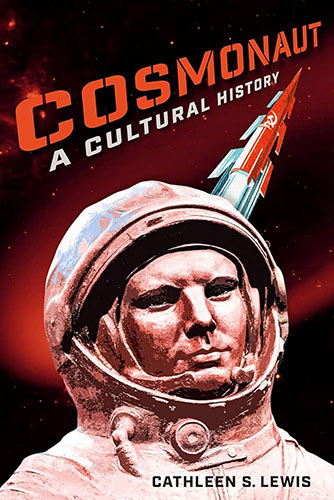Category: Nonfiction
Reviewed by: Loretta Hall
Title: Cosmonaut: A Cultural History
Author: Cathleen S. Lewis
Format: Hardcover/Kindle
Pages: 324 pages
Publisher: University of Florida Press
Date: August 2023
Retail Price: $38.00/$28.99
ISBN: 978-1683403708
Find this book
The subtitle of this book is important. Although the book contains some interesting anecdotes about specific cosmonauts, it is primarily an examination of how those space adventurers were perceived within the Soviet/Russian culture by political leaders and by ordinary citizens. It is a revealing inside look at America’s counterparts in the space race during the Cold War and the breakup of the Soviet Union.
A running theme throughout the book is the “Red Stuff”—a counterpoint to the “Right Stuff” that characterized NASA’s first astronauts. Lewis explains that “In Russian, ‘red’ has an ancient meaning associated with beauty, goodness, and honor.” Relating specifically to cosmonauts, and contrasted with America’s notion of the Right Stuff, she writes, “the Red Stuff describes the process of adding layers of meaning to the idea of Russians in space from the end of the nineteenth century through the first decade of the twenty-first. It includes the act of selecting a different and broader collection of personality, family, and cultural characteristics that best reflected the [government’s] vision of human spaceflight and deleting others that do not match contemporary expectations.” Basically, mid-twentieth-century Americans knew without anyone telling them what the Right Stuff meant, whereas in the Soviet Union, the authoritarian government told its citizens what the Red Stuff meant, in ways that permeated its society.
The author examines three methods that, along with news reports, shaped the official image of the Soviet cosmonaut. One was through the development of a personal material culture, which softened the emphasis of communal ownership of property during the Stalin era. The government encouraged the people to build personal collections of space-related memorabilia, primarily postage stamps and small pins (called znachki) decorated with images of cosmonauts and spacecraft. The stamps were produced by the government and so were some of the znachki, but commercial manufacturers also produced and sold a huge variety of the little pins. “The growth of space-themed collectible consumer goods coincided with the post-Stalinist effort to create a sense of contentment and modernity for the war-weary population,” Lewis explains.
The government also popularized its space accomplishments through the construction of museums and memorials. Secrecy kept actual launch vehicles and flown spacecraft in restricted-access government facilities; display models lacked the technical details. In part, this was because the Soviet space technology was intertwined with its military technology. In addition, Lewis writes, “Soviet engineers and managers must have understood their hardware would compare poorly in technology” with NASA’s versions.
The third avenue the Soviet government used to promote interest and pride in its space program was through state-sanctioned science fiction books and films. During the Stalin and Khrushchev eras (1924–1964), science fiction was discouraged and tightly controlled. Any books or films that were produced “conformed either to the ideology of the era, atheism, or the politically accepted style of socialist realism,” Lewis writes.
However, as the USSR evolved and eventually dissolved, restrictions relaxed and sci-fi became a vehicle for expressing the public’s dissatisfaction with Soviet policies and performance. The 1992 novella Omon Ra, one of the examples Lewis presents, is particularly poignant. It has many layers of symbolism, but the basic plot involves a man who trains as a cosmonaut, only to learn that the Soviet Union has figured out how to send a man to the Moon but is not able to bring him back. Rather than relying on technology to accomplish the trip, a sequence of cosmonauts will manually operate the spacecraft in stages to reach the Moon; this primitive activity will remain a secret because each man will kill himself when his segment of the trip is complete. All goes according to plan until Omon, the last surviving cosmonaut, triumphantly lands on the Moon. His attempt at suicide fails, however, as his gun misfires. He begins to explore the terrain and discovers that the whole trip has been a sham; he is actually in a Moon mockup beneath the streets of Moscow. He manages to escape undetected, fleeing the government’s cruel dishonesty.
Cosmonaut: A Cultural History is a scholarly work, with 77 pages of reference notes following the 217 pages of actual text. The book explores the Soviet government’s management of its space program (particularly as domestic propaganda) as well as the skepticism and resentment the authoritarian tactics produced in the general public. It is well worth reading for a broader understanding of the Cold War’s space race.
© 2024 Loretta Hall



















